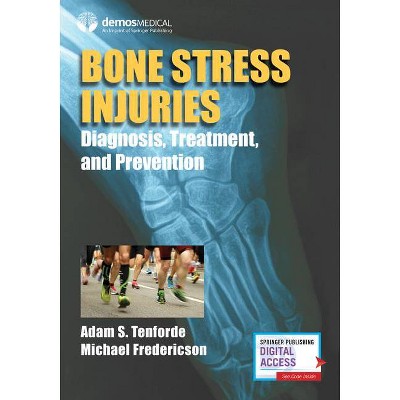Bone Stress Injuries - by Adam S Tenforde & Michael Fredericson (Paperback)

Similar Products
Products of same category from the store
AllProduct info
<p/><br></br><p><b> About the Book </b></p></br></br>"This book is organized to address aspects of clinical diagnosis, rehabilitation, and prevention. We invited experts across a range of topics to provide a more complete understanding of the full spectrum in BSI treatment. Initial chapters focus on evaluating injury, including the role of the clinical examination and imaging to guide treatment. Recognition of risk factors for BSI are separated into biological and biomechanical risk factors, including gender, age, and anatomical location. Methods to optimize treatment are reviewed in each section by anatomical location, and strategies for refractory injuries are reviewed in designated chapters on medications, emerging technologies, and interventions. Further, we identify what is known about future injury prevention and methods to optimize bone strength"--<p/><br></br><p><b> Book Synopsis </b></p></br></br><p>Bone stress injuries are commonly seen in athletes and active individuals across a full spectrum of physical activity, age, and gender. While most overuse injuries can be addressed through non-operative care, injuries may progress to full fractures that require surgery if misdiagnosed or not correctly managed. Written by leaders in sports medicine including physical medicine and rehabilitation, orthopaedics, endocrinology and allied health professionals of biomechanics, physical therapy and dietetics, <em> Bone Stress Injuries</em> offers state-of-the-art guidelines and up-to-date science and terminology to practitioners. Using a holistic approach to understand the management of bone stress injuries, this book highlights specific considerations by injury, gender, and risk factor to ensure that a comprehensive treatment plan can be developed to optimize bone health, neuromuscular re-education, gait mechanics, and injury prevention.</p> <p>Organized into four parts, opening chapters cover the general need-to-know topics, including clinical history, imaging, and risk factors including biological and biomechanical factors. The book proceeds anatomically through the body from upper extremity to foot and ankle injuries, with each chapter underscoring diagnostic and treatment strategies specific to that region. Chapters dedicated to special populations discuss the differences in injury evaluation and management according to age, gender, and military background. Final chapters review the prevention of injuries and examine both common and novel treatment strategies, such as medications, nutrition, gait retraining, orthobiologics, and other interventions. Invaluable in its scope and approach, <em>Bone Stress Injuries</em> is the go-to resource for sports medicine physicians, physiatrists, and primary care providers who manage the care of athletes and individuals leading active lifestyles.</p> <p><strong>Key Features: </strong></p> <ul> <li>Promotes evidence-based practice for diagnosis, treatment, and prevention of bone stress injuries</li> <li>Covers specific anatomy that is prone to bone stress injuries with dedicated chapters on upper and lower extremities, pelvis and hip, spine, and foot and ankle</li> <li>Considers evaluation and management differences according to specific populations of pediatric, male, female, and military personnel</li> <li>Discusses emerging strategies to treat bone stress injuries, such as gait retraining, orthobiologics, and other non-pharmacological treatments</li> <li>Purchase includes digital access for use on most mobile devices or computers</li>
Price History
Price Archive shows prices from various stores, lets you see history and find the cheapest. There is no actual sale on the website. For all support, inquiry and suggestion messagescommunication@pricearchive.us




















